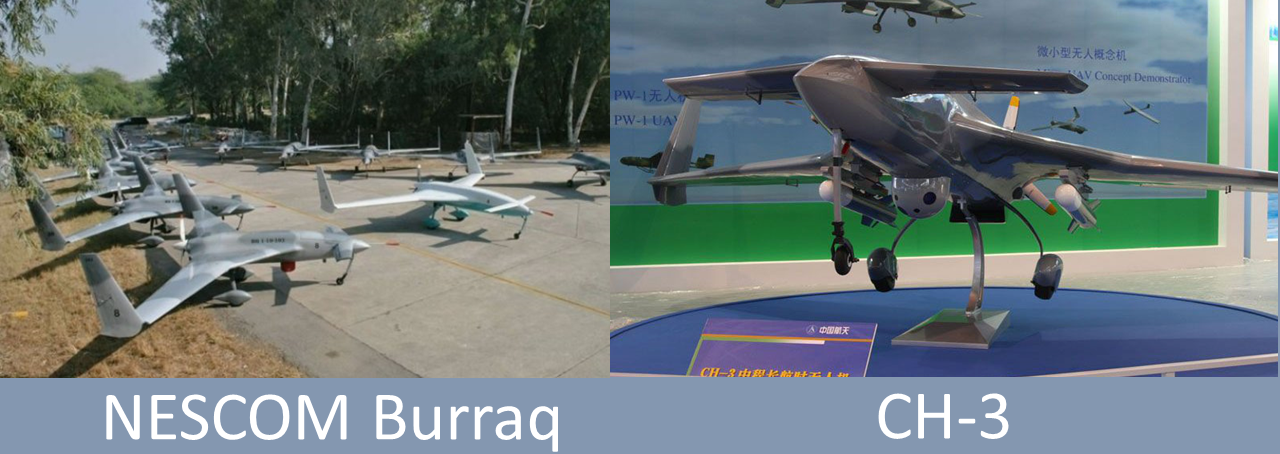Zarvan
Regular Member
- Joined
- Apr 21, 2014
- Messages
- 638
- Likes
- 300

ISLAMABAD — Pakistan has made its first acknowledged operational strike using its Burraq armed UAV, which analysts say shows a higher than expected level of sophistication in the military's real-time targeting capabilities.
The strike was confirmed via the Twitter account of the head of the military's media branch, Inter Services Public Relations, Maj Gen Asim Bajwa. A tweet dated Sept. 7 announced the first "ever use of Pak made Burraq Drone today. Hit a terrorist compound in Shawal Valley killing 3 high profile terrorists." It also said further details would follow.
The Shawal Valley in North Waziristan is the scene of a Pakistan military operation to clear out the last pockets of the Pakistani Taliban (TTP) and affiliated terrorist groups from Pakistani soil as part of the wider Operation Zarb-e-Azb.
"The Burraq and its targeting and command structure are obviously very much more sophisticated than many of us had imagined, spurring belief that [China's] influence, cooperation and input may have been considerable", said analyst Brian Cloughley, a former Australian defense attache to Islamabad. "This is not to denigrate the work of the drone manufacturer, NESCOM, which is an efficient organization, but it is extremely doubtful if its own drone technology capability is on a level that this development appears to reveal."
The Burraq and the similar Shahpar, which is said to be able to be armed, are widely believed to at least be developed from the Chinese CH-3 UAV if not license-produced versions by Pakistan's NESCOM.
Despite this milestone, there are "wider implications of drone employment [that] must be considered," Cloughley said. "In the tribal areas there is already widespread fear of drones and resentment against the government and the armed forces for the many civilian deaths that have resulted from US drone strikes. Drones and missiles don't display national identification, but even if the tribes could distinguish between US and Pakistani strikes, they would blame Islamabad for their results."
Analyst Kaiser Tufail said there are ethical issues, but Pakistan's targeting will likely be more discretionary.
"The usage of UAVs by foreign powers in other sovereign states has been a major issue, alongside the moral aspect of virtually 'clicking' to kill through impersonal and remotely actioned 'computer games,' " he said. However, "These aspects are not likely to hound countries like Pakistan, who have an own autonomous capability where the identity of insurgents is known much better than the US, which has been notorious for administering 'Hellfire' to wedding parties and funeral gatherings."
For the Pakistan Air Force, he said, this is the dawn of a new era.
"The future of warfare is getting more and more virtual," said Tufail, a former Air Force pilot. "By using UAVs, the risk of exposing pilots to being shot down is eliminated, besides the possibility of flying missions for days and weeks on end. The bio-support systems like ejection seats, oxygen supply and pressurization systems are obviated, lightening up the aircraft for more range/endurance and payload." he said.
Operationally, however, this is considerable step forward.
"The main advantage that I see is that air support does not have to be called in from long distances once a threat has emerged, and which can hide by the time the piloted aircraft arrive on the scene," Tufail said. "UAVs can loiter for hours, so the vulnerability of insurgents is also round-the-clock."
Potential interservice rivalry in UAV deployment needs to be addressed, he said.
"One of the issues I foresee is the battle of turf between the Army and the Air Force (and the Navy). Each has manufactured [or] purchased UAVs, but who uses them for what purpose has not been spelt out in any Inter-services roles and responsibilities document for UAVs," Tufail said. "This matter needs to be cleared up formally, before duplication of resources and effort takes its toll."
Email: [email protected]
http://www.defensenews.com/story/de...urprises-many-first-use-armed-drone/71881768/


 And the Pakistanis claim a massive leap in their drone technology!! Oh yeah!! Congratulations!!
And the Pakistanis claim a massive leap in their drone technology!! Oh yeah!! Congratulations!! 






